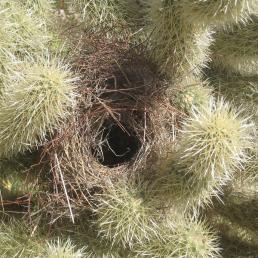

Join BirdNote tomorrow, November 30th!
Illustrator David Sibley and actor H. Jon Benjamin will face off in the bird illustration battle of the century during BirdNote's Year-end Celebration and Auction!
The Northern Mockingbird isn’t the only mimic bird in town. Brown Thrashers also learn songs from nearby birds and add them to their repertoire. The species has been documented singing over eleven hundred different songs: a mix of imitations and invented little melodies. While mockingbirds usually repeat a song or phrase three or more times before moving on, Brown Thrashers tend to repeat a phrase only twice.
This episode is brought to you by the Bobolink Foundation.
BirdNote®
The Brown Thrasher’s Never-Ending Songbook
Written by Conor Gearin
This is BirdNote.
You might know the copycat songs of Northern Mockingbirds —
[Northern Mockingbird song, ML 166628, 0:38-044]
— but they’re not the only mimic birds in town. Brown Thrashers also learn songs from nearby birds and add them to their repertoire.
[Brown Thrasher song, ML 98812, start at 1:03, fade under next sentences]
The species has been documented singing over eleven hundred different songs: a mix of imitations and invented little melodies. While mockingbirds usually repeat a song or phrase three or more times before moving on, Brown Thrashers tend to repeat a phrase only twice.
[Brown Thrasher song, ML 98812, 1:41-1:46]
Brown Thrashers are striking birds, with bright yellow eyes, cinnamon-brown back and wings, and a white breast with dark streaks. They swing their large beaks through leaves on the ground to uncover seeds and insects.
The species nests in hedges and shrub thickets. Its population has declined by about 41% since 1966, as its nesting habitats have dwindled.
Brown Thrashers live year-round in the Southeastern U.S., and breed in the Northeast, Midwest, and Great Plains. Getting to know your local thrasher can be rewarding — you never know when they might have a new song to perform.
[Brown Thrasher song, ML 98812, 2:25-2:29]
For BirdNote, I’m Ariana Remmel.
This episode is brought to you by the Bobolink Foundation.
###
Senior Producer: John Kessler
Content Director: Allison Wilson
Producer: Mark Bramhill
Associate Producer: Ellen Blackstone
Managing Producer: Conor Gearin
Bird sounds provided by The Macaulay Library of Natural Sounds at the Cornell Lab of Ornithology, Ithaca, New York. Northern Mockingbird ML 166628 recorded by R. Bethel, and Brown Thrasher ML 98812 recorded by G. Keller.
BirdNote’s theme was composed and played by Nancy Rumbel and John Kessler.
© 2022 BirdNote March 2022 Narrator: Ariana Remmel
ID# BRTH-01-2022-03-23 BRTH-01
References: https://birdsoftheworld.org/bow/species/brnthr/cur/introduction
https://bioone.org/journals/the-condor/volume-119/issue-3/CONDOR-17-83…
BirdNote®
The Brown Thrasher’s Never-Ending Songbook
Written by Conor Gearin
This is BirdNote.
You might know the copycat songs of Northern Mockingbirds —
[Northern Mockingbird song, ML 166628, 0:38-044]
— but they’re not the only mimic birds in town. Brown Thrashers also learn songs from nearby birds and add them to their repertoire.
[Brown Thrasher song, ML 98812, start at 1:03, fade under next sentences]
The species has been documented singing over eleven hundred different songs: a mix of imitations and invented little melodies. While mockingbirds usually repeat a song or phrase three or more times before moving on, Brown Thrashers tend to repeat a phrase only twice.
[Brown Thrasher song, ML 98812, 1:41-1:46]
Brown Thrashers are striking birds, with bright yellow eyes, cinnamon-brown back and wings, and a white breast with dark streaks. They swing their large beaks through leaves on the ground to uncover seeds and insects.
The species nests in hedges and shrub thickets. Its population has declined by about 41% since 1966, as its nesting habitats have dwindled.
Brown Thrashers live year-round in the Southeastern U.S., and breed in the Northeast, Midwest, and Great Plains. Getting to know your local thrasher can be rewarding — you never know when they might have a new song to perform.
[Brown Thrasher song, ML 98812, 2:25-2:29]
For BirdNote, I’m Ariana Remmel.
This episode is brought to you by the Bobolink Foundation.
###
Senior Producer: John Kessler
Content Director: Allison Wilson
Producer: Mark Bramhill
Associate Producer: Ellen Blackstone
Managing Producer: Conor Gearin
Bird sounds provided by The Macaulay Library of Natural Sounds at the Cornell Lab of Ornithology, Ithaca, New York. Northern Mockingbird ML 166628 recorded by R. Bethel, and Brown Thrasher ML 98812 recorded by G. Keller.
BirdNote’s theme was composed and played by Nancy Rumbel and John Kessler.
© 2022 BirdNote March 2022 Narrator: Ariana Remmel
ID# BRTH-01-2022-03-23 BRTH-01
References: https://birdsoftheworld.org/bow/species/brnthr/cur/introduction
https://bioone.org/journals/the-condor/volume-119/issue-3/CONDOR-17-83…





